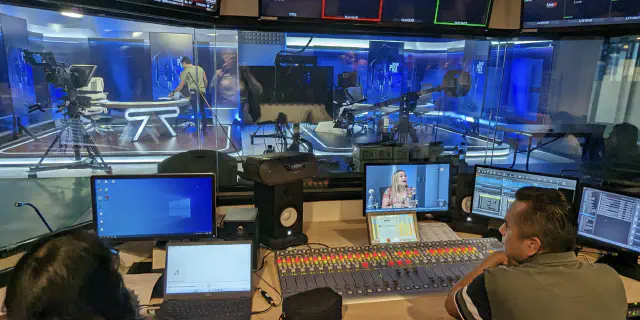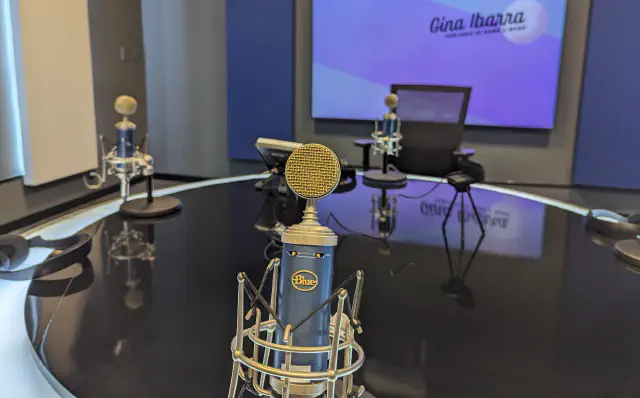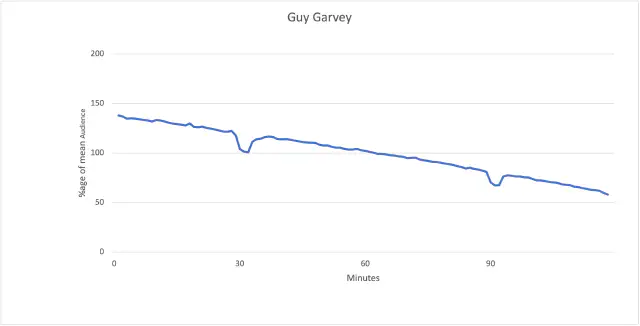A look round Radio Fórmula

Wandering around a national radio station wasn’t my plan when I got to Mexico City last month; but that’s what I ended up doing.
Grupo Fórmula owns Radio Fórmula, which has three national networks of news/talk channels, as well as a national TV network. I found myself - after giving reception my Australian driving licence (to much excitement by virtually everyone who’d never heard of Queensland) - going up in the elevator to Radio Fórmula’s tiny and bustling floor in a brand new building in the Polanco district.
The facility is new: brand new. It only opened in March 2023. It’s a brave reimagining of how a radio station should look and feel - almost unrecognisable as a radio station, to be honest.
The centre of the building contains a number of studios. Almost all of them are TV studios: with mixing desks for both video and audio. Cameras are, mainly, automated. There’s a large double-studio used for some of the biggest shows.
I was introduced to Maxine Woodside, the “Queen of the Radio”, who chatted amiably to me before calmly wandering into the studio next door, sitting down, and within sixty seconds, starting her show Todo para la Mujer. She’s done that show since 1989.
It was astonishing how much the company had packed in to what seemed to me like a quite small space. One side of the floor is for management offices; one side for small two-person production studios (all with the permanent time-bookings marked on the door); one side contained a hive of activity with around thirty journalists and production staff in lines of desks.

Radio studios, all clustered around the middle, included some big and some rather smaller spaces, but all well lit and TV-capable. They seem to be fans of Blue microphones here.
There was the main TV control room, too. As I understand it, they’re live on a number of different platforms, including YouTube and Facebook; here’s a clip of the sort of thing you’d see, including some VT to brighten up the piece for the TV; or this clip from the breakfast show.
I even got to peer into the racks room, which, I’m happy to report, looked like every other racks room I’ve seen.
I also had a quick chance to see the Group CEO, Guillermo Nuñez Herrera. The company is experimenting with AI newsreaders for some short-form TV content - for news, sport, business, etc, each has its own personality, he showed me on the television in his office.
He’s proud of what he’s achieved, moving the station from its 22 year-old building in Avenida Universidad to a brand new, incredibly futuristic setting in Polanco. And so he should be: it’s an impressive, yet efficient, reimagination of a radio facility.
I was there as a guest of the podcast host RSS.com, who formed an exclusive distribution, co-production and sales relationship with Grupo Fórmula in 2021.
RAJAR released its MIDAS research for Q3/23. The UK data shows consumption patterns for all internet-connected audio (as well as radio on whatever platform).
The skew of podcasts to be a thing for young people continues to show itself; and there has been a doubling of the amount of people who listen to podcasts since 2017.
Rather more interestingly, though, it shows total time spent listening to podcasts (now 90mn hours a week). It’s a number I think we should be taking more attention of.
Among US podcast listeners, time spent listening to podcasts is not increasing. Edison Research says that podcast listeners were listening to 1 hr 44 minutes of podcasts in 2014 (a day - roughly 12.2 hours a week), but podcast listeners listen to the same amount now. There are, of course, many more podcast listeners; and the total time spent listening to podcasts as a whole has grown almost 5x in nine years.
Yet, in the UK, MIDAS says that the total amount of podcast listening per listener is growing. I worked these figures out earlier this year for Podnews, but never published them for some reason. Anyway:
In Spring 2017, 10.2% of the population (54.466mn) listened to 30 million hours of podcasts weekly: 5.5mn listeners, listening to 30mn hours = average 5.4 hours each a week
In Spring 2023, 22.8% of the population (56.348mn) listened to 91 million hours of podcasts weekly: 12.8mn listeners, listening to 91mn hours = average 7.1 hours each a week
Unsurprising that RAJAR reports less time listening overall; but as better, more interesting podcasts appear, you would expect the time spent listening (per listener) to increase. I wonder why it isn’t doing so in the US?
The BBC has looked at how listeners - and viewers - skip their shows on BBC iPlayer or BBC Sounds. Of course, the BBC contains no ad-breaks, so you don’t see any evidence of that; but in the piece, it’s worth looking at Guy Garvey’s radio show - Guy Garvey’s Finest Hour, which is perplexingly three hours long.

Unsurprisingly, the big dips here relate to the old news bulletins, which remain in the audio. There’s an argument to suggest that the BBC might edit those old news bulletins out of the listen-again recording.
There is, I notice pleasingly, a little precedent for editing: the Corporation now appears to be “topping” the show properly so it starts at exactly the right place - something I suggested in 2008 might be good for listeners, to be told that nobody cared.
The other thing that is interesting is a “linear decline”. “People stop playback for reasons unrelated to the content. These programmes are filling in time for the audience.”
It’s a great piece of research, and worth a read.
The American WIRED magazine writes a half-hearted piece about the best radios to catch your favorite airwaves, a rather confusing headline. Of the radio receivers it promotes, none have HD Radio, and all have analog dials.
In Australia, the music rights agencies are fighting commercial radio once more for money, in a seemingly regular spat. 25% of music output must be Australian. Ford Ennals says commercial radio pays $40mn a year in music fees; and the article appears to suggest that commercial radio plays 0.4% of total revenue for sound recordings, 3.76% for songwriters (publishers, presumably), and a capped 1% for artists. At 5.16% that’s half of what UK broadcasters pay-out (though considerably more than US radio).
Spencer Howson has announced he’s leaving 4BC in Brisbane. He did the announcement wearing a Radiodays Europe t-shirt that I gifted him; he claims it was first out of the wardrobe, but I rather doubt it. His last shows are this weekend; Peter Fegan takes his place. While Spencer protests that he isn’t looking to be in front of the microphone any more, I doubt we’ve heard the last of him on the air.
Want to supercharge your radio show? Here’s a £1 week-long trial of Show Prep - from a world class radio consultant and the best show-prep writer in the UK. Great for UK stations, or for English-language stations everywhere, too. (ad)
Coming up…
I’m speaking at Radiodays Europe in Munich, probably at an event a few days before in Oslo, probably at Podcast Movement Evolutions in Los Angeles, all in March.
I’ll also be at The Podcast Show in London in May, Podcast Movement itself wherever it is later in the year, Radiodays Asia when it returns in September in KL, and a number of other events.
Supporters
Thank you to Broadcast Radio, Clyde Broadcast. Richard Hilton and James Masterton, Brun Audio Consulting, Soma FM and Media Realm’s MetaRadio.
If you’d like to support my work in any way, you can BuyMeACoffee - become a member to give regularly or just give a one-off coffee, or five. Here’s where to do that.
Please do follow me on Mastodon, too: I’m @james@bne.social there. I’m much more active there than anywhere else.
My professional website has more detail about who I am, and what I do, and whether I can help you further; and you can hear this newsletter being read to you on a podcast player near you - just search for “James Cridland - radio futurologist”.
My newsletter is supported by:
Selected bits from Radioland are in RadioInfo in Australia, and RAIN News in the US
Lesen Sie außerdem ausgewählte Artikel auf Deutsch in Radioszene
Previously:
Next:
Managing your American Airlines flight from a Qantas booking's PNR